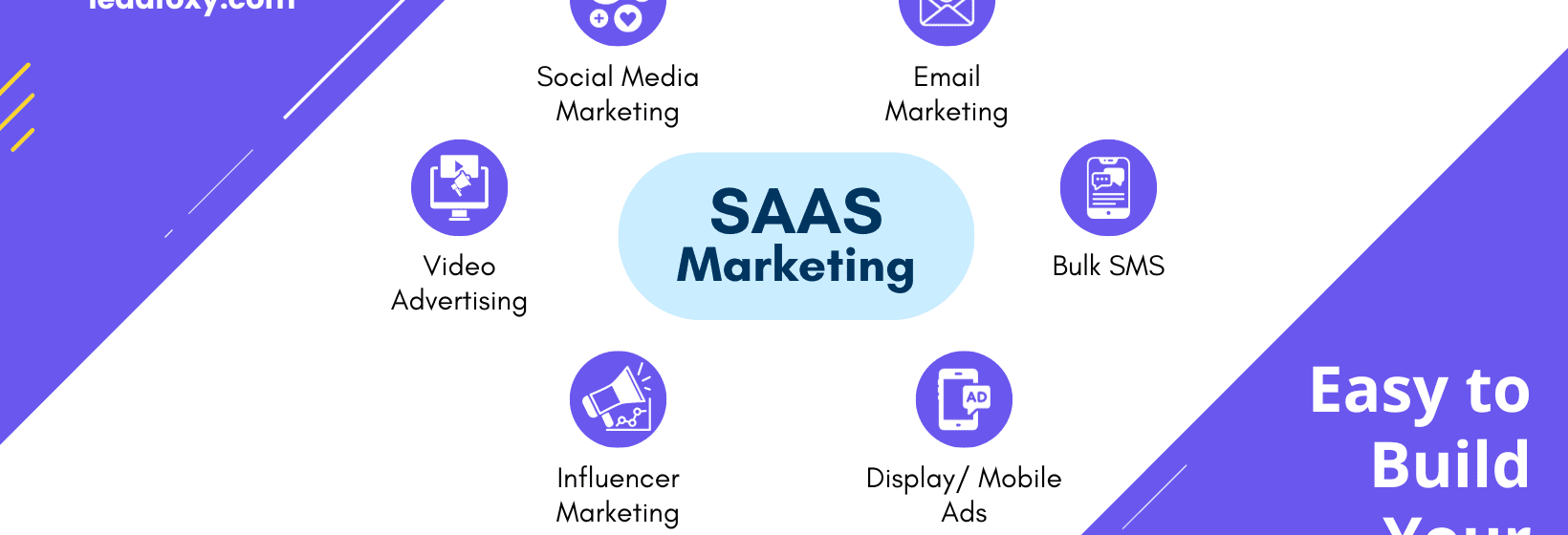SaaS marketing is the strategy of promoting and selling cloud-based software applications that are accessed through the Internet. SaaS marketing differs from traditional software marketing in several ways.
Since SaaS products are typically sold on a subscription basis, SaaS marketers need to focus on building long-term customer relationships. Due to the broad potential customer base for SaaS products, marketers must utilize a variety of channels to connect with their target audience.
What sets SaaS Marketing apart from Traditional Marketing?
Both SaaS marketing and traditional marketing aim to sell products or services to potential customers. However, due to the nature of SaaS products and how they are sold, there are some key differences between the two approaches.
Here are some of the key differences between SaaS marketing and traditional marketing:
- Target audience: SaaS marketing tends to focus on a more targeted audience because SaaS products are often designed to solve specific problems for specific types of customers. Traditional marketing, on the other hand, may use a broader approach to reach a wider audience.
- Marketing channels: To attract visitors to their websites and convert them into potential customers, SaaS marketers employ a variety of digital marketing strategies, including search engine optimization (SEO), content marketing, and social media marketing on platforms like Facebook, Twitter, and Instagram. Traditional marketing, on the other hand, may also incorporate digital channels but is more inclined to rely on conventional methods such as print and television advertising.
- Sales cycle: SaaS products typically have shorter sales cycles than traditional products. This is because SaaS products are generally easier to demonstrate and test, and customers can usually start using them right away. Traditional products may require longer sales cycles because they are more complex or require more customization.
- Customer retention: Customer retention strategies are emphasized by SaaS marketers as they offer a more economical approach to business growth compared to customer acquisition efforts.Traditional marketers may also focus on customer retention, but this is not as critical to their success.
- Data-driven: SaaS companies’ access to extensive customer data enables them to implement data-driven marketing initiatives.This data can be used to personalize the customer experience and improve marketing campaigns. Traditional marketing may also use data, but it is not central to its strategy.
Here is a table of the key differences between SaaS marketing and traditional marketing:
| Feature | SaaS marketing | Traditional marketing |
| Target audience | Targeted | Broad-based |
| Marketing channels | Digital | Digital and traditional |
| Sales cycle | Shorter | Longer |
| Customer retention | Critical | Important |
| Data-driven | Highly data-driven | Less data-driven |
SaaS marketing emphasizes fostering customer relationships and delivering enduring value, whereas traditional marketing prioritizes lead generation and sales conversions.
Key Steps for Developing an Effective SaaS Marketing Strategy
A comprehensive SaaS marketing strategy is critical to the success of any software-as-a-service (SaaS) company. It helps companies attract new customers, retain existing ones, and drive sales growth.
Here is a step-by-step guide to creating an effective SaaS marketing strategy:
Define target audience and create buyer personas:
- Identify your targeted customers profile, including demographics, pain points, and decision-making process.
- Develop comprehensive buyer personas that embody distinct segments of your target market.
Establish clear marketing goals:
- Define well-defined, measurable, achievable, relevant, and time-bound goals to optimize your marketing initiatives.
- Align your marketing goals with overall business goals.
Conduct competitive research:
- Analyze competitors’ strengths, weaknesses, and marketing strategies.
- Identify market trends and opportunities that you can capitalize on.
Choose the right marketing channels:
- Choose the right effective channels to reach your potential customers, such as Content marketing, email marketing, social media marketing (like facebook, Twitter), SEO (Search Engine Optimization) , and paid advertising.
- When choosing a marketing channel, consider your budget, resources, and expertise.
Craft a compelling value proposition:
- Clearly articulate the unique value your SaaS product provides to your customers.
- Highlight how your product solves a specific pain point and improves its business outcomes.
Create high-quality content:
- Create informative and impactful content that aligns with the customers interests and needs of your target market.
- Use different content formats like blog posts, infographics, videos, and webinars.
Optimize your website for conversions:
- Make sure your website is user-friendly, mobile-friendly, and visually appealing.
- Implement a clear call-to-action (CTA) to guide visitors through the conversion funnel.
Embrace retention marketing:
- Focus on nurturing relationships with existing customers to increase customer lifetime value (CLTV).
- Implement strategies such as customer loyalty programs, personalized email campaigns, and regular product updates.
Measure and analyze your results:
- Track key marketing metrics like website traffic, lead generation, and conversion rates.
- Use data analytics to identify improvement opportunities and optimize your marketing strategy.
Continuously refine and adapt your strategy:
- Review your marketing strategy regularly and adjust based on data and market conditions.
- Stay informed about emerging marketing trends and technologies.
What is the SaaS Marketing Funnel?
A SaaS marketing funnel is a multi-step process that helps SaaS companies attract, retain, and convert leads into paying customers. For SaaS companies, understanding the customer journey is crucial for optimizing marketing and sales strategies.
Understanding the Functionality of the SaaS Marketing Funnel
A SaaS marketing funnel is a multi-step process that helps companies attract, retain, and convert leads into paying customers. It is a vital tool for SaaS companies as it helps them maximize their sales and marketing efforts.
A SaaS marketing funnel typically consists of the following stages:
- Awareness: At the outset of the sales funnel, the primary objective is to familiarize potential customers with your SaaS offering. The successful execution of this goal is contingent upon the implementation of a comprehensive marketing strategy that encompasses content marketing, social media marketing, and search engine optimization (SEO).
- Engagement: After capturing the attention of prospective clients, it is crucial to maintain engagement and foster their interest. This can be achieved through the provision of valuable content, such as insightful blog posts, compelling white papers, and real-world case studies. Additionally, email marketing can serve as an effective tool to nurture relationships with potential customers and keep them informed about your offerings.
- Desire: The goal of the demand stage is to get potential customers to want your product. This can be accomplished by emphasizing the benefits of the product and how it solves your problem. Utilize testimonials from satisfied customers to validate your brand’s claims and establish a reputation for excellence.
- Conversion: The conversion stage marks the pivotal moment when a prospective customer transforms into a valued paying customer. This crucial transition can be facilitated through a range of strategies, including enticing free trials, engaging demos, or informative webinars. Additionally, strategically crafted landing pages and compelling calls to action (CTAs) can effectively guide potential customers towards taking the next decisive step.
- Retention: Once you convert prospects into customers, it’s important to retain them. This is achieved through excellent customer service, ongoing support, and regular release of product updates. You can also use a loyalty program to reward customers for their continued business.
SaaS marketing funnels are not linear journeys; customers can meander through stages in varying patterns. Continuously monitoring your funnel, tracking progress, and identifying areas for improvement is crucial for optimizing results.
Highly Successful Strategies and Channels for SaaS Marketing
SaaS marketing funnels are dynamic and fluid, with customers often revisiting and progressing through different stages at their own pace. It’s crucial to continuously monitor your funnels performance, track key metrics, and pinpoint areas for optimization to enhance outcomes.
Content Marketing: Generate insightful and informative content that tackles the challenges and interests of your target audience. This can encompass blog posts, articles, infographics, webinars, and videos. Share this content in your website, social media channels, and industry publications to establish thought leadership and attract potential customers.
Search Engine Optimization (SEO): Enhance your website’s visibility and attract more customers by optimizing your content for search engines. Employ relevant keywords, earn backlinks, and ensure your website is mobile-friendly. These SEO strategies will boost organic traffic, making it easy for your targeted customers to discover your SaaS product solutions when they search online.
Paid Advertising: Employ paid advertising platforms such as Google Ads and Facebook Ads to strategically expand your reach, attract a targeted audience, and drive high-quality website traffic.Utilize pay-per-click (PPC) advertising to strategically display your ads to users actively searching for keywords relevant to your SaaS product. Additionally, harness the power of social media advertising to meticulously target specific audiences based on their interests and demographics.
Email Marketing: Construct an extensive email list and nurture connections with potential clientele through carefully designed email marketing efforts. Share valuable content, offer discounts, and announce new product features to engage your audience and guide them into the sales funnel.
Social Media Marketing: Cultivate an active and engaging social media presence on LinkedIn, Twitter, and Facebook.Share engaging content, join industry conversations, and respond to customer inquiries promptly to increase brand awareness and cultivate a loyal community.
Affiliate Marketing: Partner with complementary companies and influencers in your industry to promote your SaaS product. Embrace affiliate marketing as a strategic approach to widen your audience reach and nurture lead generation.
Free Trials and Freemium Plans: Offer a free trial or freemium plan for your SaaS product so potential customers can experience its value before committing to a paid subscription. This can be a powerful conversion tool, especially for complex or high-value SaaS products.
Customer Success and Retention: Prioritize customer success by providing exceptional onboarding, support, and training. Focus on retaining existing customers by being responsive to their needs, offering a loyalty program, and regularly improving your SaaS product.
Partnerships and Integrations: Work with complementary companies to develop integrated or strategic partnerships. This enables you to expand your business reach, provide added value to your customers, and open up new revenue streams.
Analytics and Measurement: Continuously track and measure the performance of marketing campaigns and programs. Use data-driven insights to refine your strategy, optimize your spending, and maximize the ROI of your marketing efforts.
The most effective SaaS marketing strategies are tailored to your company’s specific needs and goals.
Which SaaS Metrics and KPIs Should You Monitor?
While traditional marketing aims to convert customers quickly, SaaS marketing focuses on cultivating lasting relationships with your customer base. This includes understanding your audience’s challenges, demonstrating the value of your solution, and ensuring your products value remains long after the initial conversion.
Discover the power of LeadFoxy, a website visitor tracking tool designed to help B2B SaaS companies identify and convert high-quality leads. Try it out for yourself with our 7-day premium free trial.




